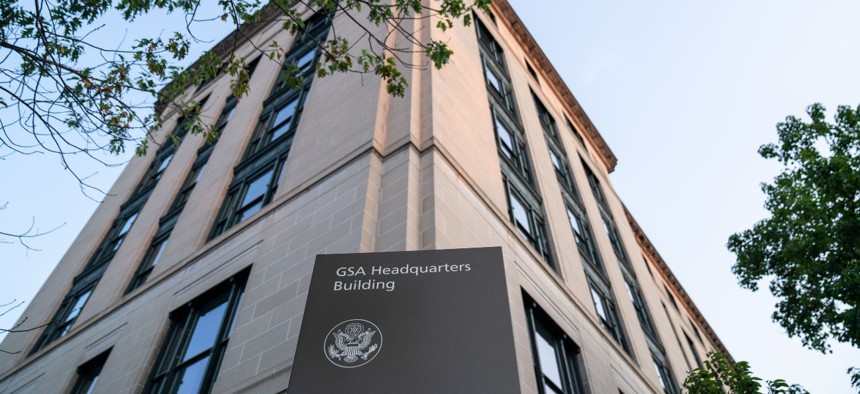Most Agencies Plan to Cut Back on Office Leases and Square Footage in the Next 3 Years, Watchdog Finds
GSA should share insights as agencies plan for their post-pandemic real estate needs, GAO says.
The federal government’s landlord should share widely with agencies the insights it has collected on office space use as they make their post-pandemic plans, according to a watchdog.
The future of work has been top of mind for many, across industries, for some time now. The COVID-19 pandemic is over two and a half years old and many workplaces have made or are in the process of changing their work policies based on lessons learned from the pandemic.
“While agencies are beginning to resume more in-person operations and some employees are returning to federal spaces, it is clear that the federal workplace is evolving and is likely to include a significant increase in hybrid and remote office environments,” said a report from the Government Accountability Office published on Wednesday. “These changes will undoubtedly have a large impact on the demand for federal office space, leased and owned, and could create an opportunity to restructure the federal government’s real property portfolio and meet agencies’ office space needs.”
From March 2020 to March 2022, 17 of the 24 major agencies surveyed by GAO said they only made limited reductions of their office space due to the pandemic, while some leases had to be extended due to pandemic related challenges. According to officials that GAO interviewed at five select agencies, the reasons agencies didn’t let go of a large amount of federal space during the pandemic were: uncertainty about the future of work, prioritization of employee safety and mission, lease terms, and the concerns that the process to get rid of unneeded space was lengthy and might not yield cost savings.
“Although the decrease in federal leases specifically influenced by the pandemic has been limited, it continued and somewhat accelerated the federal government’s historical trend of reductions in leased space assets,” the report noted.
Furthermore, over the next three years, 16 out of the 24 agencies GAO surveyed expect to continue reducing their number of leases and 19 of 24 expect to continue reducing their square footage in their real estate portfolio. The main reason for this is increases in telework due to the pandemic. Also, as of March 2022, more than half (4,325 out of 7,754) of the leases of GSA–– which is in charge of federal leases and owned spaces on behalf of the U.S. government––have expiration dates for calendar years 2022 to 2026.
Agencies surveyed by GAO said the following factors will be critical in their future office planning: lease contract flexibilities, telework policies and office space design.
GSA “has taken some steps to support federal office space-planning in the post-pandemic environment,” such as by increasing ongoing federal office space planning services and pilot testing technologies to collect data on space utilization (such as the number of people in buildings on a daily or hourly basis) and other data on space utilization at GSA-leased facilities and federally owned properties, said the report. “However, GSA has no plans to widely share information that it is gathering in pilot programs and data collection efforts, and that sharing could help agencies better understand their future space needs.”
GSA is responsible for about 1,500 of the more than 19,500 buildings owned by the federal government and therefore some agencies might not be privy to the GSA’s data collection efforts, said GAO. Moreover, “most agencies we surveyed said that they have never received information on how to collect or use space utilization data from GSA (16 of 24 agencies), and that more information on space utilization data from GSA would be helpful (13 of 24 agencies),” said the report.
“As the federal government’s property manager, GSA is well positioned to provide agencies with information to help them decide whether collecting space utilization data is cost-effective,” the report continued. “GSA is accustomed to sharing information on real property planning with federal agencies through reports, webinars and its agency website.”
As a result of review, GAO recommended that the GSA administrator devise a plan to share broadly with the agencies, including those that don’t use GSA’s services, insight from GSA’s data collection efforts on space utilization. Robin Carnahan, GSA administrator, said in a response to GAO that GSA agrees with the suggestion.
Carnahan is one of the co-chairs of the Safer Federal Workforce Task Force, which has been issuing guidance since it was established by President Biden upon taking office on building operations, COVID-19 vaccination and testing policies, leave, labor relations and more.
During his State of the Union address in March, President Biden said “the vast majority of federal workers will once again work in person,” but those decisions are being made on an individual agency (or team) basis in coordination with White House guidance.
GAO’s report comes as agencies are being tasked with submitting their fiscal 2024-2028 capital plans to the Office of Management and Budget and the Federal Real Property Council by December 16. OMB Director Shalanda Young issued a July memo asking agencies to consider flexibilities that expanded during the pandemic such as telework and hybrid work as they create their capital plans.








